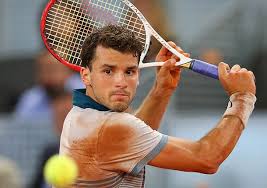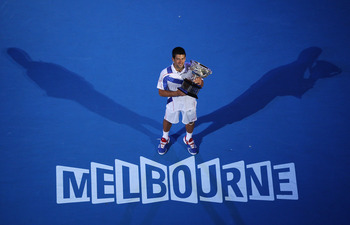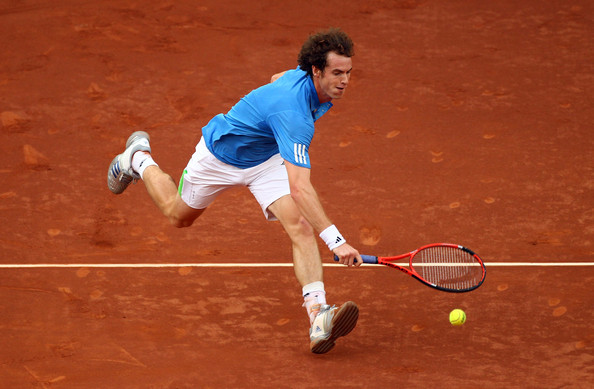Grigor Ditmitrov Upset World No. 1 Novak Djokovic in Madrid
The Madrid Match: Dimitrov 7-6, 6-7, 6-3
If you watched the match on Tuesday between world No. 1 Novak Djokovic and Bulgarian Grigor Dimitrov, currently ranked world No. 28, perhaps you witnessed an historic match—much like the fourth round match between Pete Sampras and Roger Federer at Wimbledon in 2001.
The Swiss defeated Pistol Pete in five thrilling sets to send the American packing. Sampras would never again reign on Center Court after seven Wimbledon championships while Federer showed the world he could win the big one.
Like Federer, Dimitrov may not capitalize immediately but what the match fully illustrated was that the Bulgarian could win over the best. That critical step Dimitrov took today should instill him with enough confidence to stand toe to toe with anyone on court today. Time will tell, however, whether this match stands the test of time.
Both combatants mesmerized tennis fans around the globe as the match ebbed and flowed first in Dimitrov’s favor, then in Djokovic’s. The Serb never quit trying to will his way across the finish line. When Dimitrov took the first set tie-break, we all believed that Djokovic was in a dog-fight—but one that he would win—eventually.
The second set unfolded with Djokovic down again, figuratively and literally, as he slipped on the baseline, temporarily injuring an already tender right ankle. But Djokovic righted the ship and won the second set tiebreak.
At that point we all believed that Dimitrov had fought the good fight—but surely the world No. 1 had the momentum to finish the youngster off in the third set. But 3 hours and 5 minutes later, Djokovic was gone and a new potential champion was left standing.
The Consequences for the Rest of the Field
It has been over three months since the 2013 Australian Open concluded, cementing the No. 1 status of Novak Djokovic.
Djokovic captured his fourth Australian Open Crown—three in the past three years. This pushed him ahead of Federer, who has also won four, but only two consecutively. No male since Aussie Roy Emerson, has won three Australian Championships in a row. Emerson won five—from 1963-1967, all prior to the start of the Open Era in tennis.
It seems the charismatic Serb had arrived, embracing his role as the new man to beat in men’s tennis. Djokovic was riding high. Currently he remains over 4300 points ahead of world No. 2 Roger Federer.
In the process of capturing another crown in Melbourne, Djokovic defeated Andy Murray—again. At one point it seemed Murray was the proverbial runner-up in his quest to win his first grand slam title while Djokovic, his brother in arms, overcame his youthful tics to become a complete player—a champion.
But then Murray won the 2012 US Open in Flushing Meadows to get that monkey off his back. Now all the Scot must worry about is winning Grand Slam No. 2.
Rafael Nadal, who spent over six months on the sidelines in an attempt to overcome his suspect knees, has “almost” returned to form on the forgiving clay courts. He did win the one hard-court tournament he entered in 2013—Indian Wells, defeating Argentine Juan Martin del Potro in the final.
But Nadal lost to Djokovic during the final of the Monte-Carlo Masters, ending his chance to win that title a record breaking nine consecutive times. It was a bit of shock to the Spaniard’s legion of fans.
Both Nadal and Federer have slowed their pace considerably in 2013, entering fewer tournaments, saving their bodies for the physical grind awaiting them during the upcoming 2013 summer.
Federer, age 31 and Nadal, age 26, are both recovering, trying to stave off any serious injuries that could limit their campaigns in the latter half of 2013 starting with the French Open. Federer’s back seems fully recovered while Nadal continues to test his knees hoping they will sustain him for another few years.
Federer is no doubt playing Madrid simply because he won the event a year ago and would lose too many points by skipping it. Plus the Swiss needs clay court battles prior to the start of the 2013 French Open.
On Tuesday, Federer faced wily veteran Radek Stepanek in his opening round match in Madrid. It might have been tricky since it was Federer’s first match in over two months. But Federer showed only a few signs of rust as he put Stepanek down 6-3,6-3.
The next match up found Andy Murray facing another seasoned veteran in Florian Mayer of Germany. It was Murray’s first match since the Scot went out in the third round in Monte Carlo against a very hot Stanislas Wawrinka of Switzerland. Murray reached the quarterfinals at both Monte Carlo and Madrid in 2012.
But the hope of reaching that far in Madrid seemed in doubt as Mayer extended the Scot to two tiebreaks which Murray managed to win 7-6, 7-6. The Scot will be hoping to reach at least the quarterfinal plateau at this week’s tournament.
Djokovic, on the other hand, faced an up-and-coming Grigor Dimitrov of Bulgaria in a night match under the lights. At age 21, no doubt, Dimitrov will become the future face of tennis. But right now, that spot still belongs to Djokovic who will not be discouraged by losing his opening match this week.
His sights are firmly fixed on Roland Garros in 2013. There the world No. 1 hopes to complete a career Grand Slam—and who knows, maybe a calendar year Grand Slam may still be within the realm of possibilities.
Last year, Nadal was defeated in Madrid by Fernando Verdasco on the stunning blue clay of Manolo Santana—which he hated. Nor was he hesitant in making his feelings known. In fact, Nadal and Djokovic threatened to boycott this event if the blue clay returned in 2013.
This year, most players were pleased to note a traditional red clay court surface with conditions reportedly a bit slower than last year’s slick blue clay. Tiriac’s grand experiment to make Madrid stand out—was laid to rest without much comment from Madrid Tournament Officials. Nadal will open his Madrid campaign against Benoit Paire of France when action gets underway on Wednesday.
Potential Madrid Winners and Losers:
At the conclusion of the tournament, most pundits picked the tried-and-true top four to reach the semifinals, bypassing true world No. 4, David Ferrer whose workman like efforts to reach that top spot get little respect—at least not the respect the Spaniard deserves. The fact that Ferrer must face Nadal—whom he has defeated on clay only once—back in Stuttgart in 2004—explains such reasoning.
In the semifinals, that would pit Nadal against Federer whose record against the Spaniard on clay speaks for itself. Federer is the defending champion but with current conditions and the Swiss’ lack of match play, you would have to give the nod to Nadal in this match.
This means that if Murray gets his teeth into this tournament, he should emerge from Madrid as the new world No. 2—a spot he held briefly back in April of this year. Murray would then have to face Dimitrov or whomever reaches the semifinals of Madrid. Most will pick the current world No. 3 to emerge from that contest to advance to the final.
Madrid, however, has never been a tournament that Nadal dominated—unlike the other clay court tournaments during this European swing. Since 2005, Nadal has won the Madrid title twice. Perhaps, Murray has a real opportunity to win here. The Scot has never won in Madrid—in fact, it would mark Murray’s first ever clay court title.
But, with the eviction of Djokovic, Nadal becomes the obvious favorite to win this title and strengthen his majesty on clay in preparation for his obvious goal awaiting in Paris.
Madrid, then Rome, pave the way for the 2013 French Open which is still wide open at this point with all the players fully engaged and ready to rumble.


